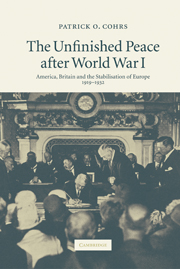Book contents
- Frontmatter
- Contents
- Acknowledgements
- List of abbreviations
- A note on the footnotes and bibliography
- Introduction
- Prologue
- 1 The wider challenges
- 2 Wilson, Lloyd George and the quest for a ‘peace to end all wars’
- 3 The ill-founded peace of 1919
- 4 The escalation of Europe's post-Versailles crisis, 1920–1923
- Part I The Anglo-American stabilisation of Europe, 1923–1924
- Part II Europe's nascent Pax Anglo-Americana, 1924–1925
- Part III The unfinished transatlantic peace order: the system of London and Locarno, 1926–1929
- Epilogue
- Conclusion
- Map: Post-World War I Europe after the peace settlement of Versailles
- Bibliography
- Index
Part III - The unfinished transatlantic peace order: the system of London and Locarno, 1926–1929
Published online by Cambridge University Press: 21 July 2009
- Frontmatter
- Contents
- Acknowledgements
- List of abbreviations
- A note on the footnotes and bibliography
- Introduction
- Prologue
- 1 The wider challenges
- 2 Wilson, Lloyd George and the quest for a ‘peace to end all wars’
- 3 The ill-founded peace of 1919
- 4 The escalation of Europe's post-Versailles crisis, 1920–1923
- Part I The Anglo-American stabilisation of Europe, 1923–1924
- Part II Europe's nascent Pax Anglo-Americana, 1924–1925
- Part III The unfinished transatlantic peace order: the system of London and Locarno, 1926–1929
- Epilogue
- Conclusion
- Map: Post-World War I Europe after the peace settlement of Versailles
- Bibliography
- Index
Summary
How far could the nascent transatlantic peace order after World War I be consolidated? What made it so susceptible to collapse under the impact of the World Economic Crisis? These are far-ranging questions on which the final part of this study, and its epilogue, nonetheless seek to shed some new light.
Focusing on the European stage, some earlier studies have claimed that the Locarno treaty system overall functioned well until succumbing to the Great Depression's overwhelming pressures. Others have asserted that the clash between French and German aims became even more pronounced after Locarno – yet that neither British, German nor French policies evolved further. Allegedly, the ‘edifice’ of Locarno thus eventually collapsed because Chamberlain, Briand and Stresemann missed opportunities. There has also been the view that they simply could not overcome what proved critical: towering domestic obstacles to international conciliation, chiefly in France and Germany.
Most resonant, however, remains the ‘realist’ condemnation of Locarno-style ‘tea-party’ diplomacy, asserting that it had to fail because it rested on false premises. Its deepest flaw was, allegedly, that it continued to disregard, and erode, what alone could have contained Germany's unchangeable revisionism: balance-of-power prescriptions. By a similar token, Anglo-American efforts to complete Germany's rehabilitation allegedly went ever further in compromising eastern Europe's, and particularly Poland's, consolidation prospects. This was also a widely held, yet not the only, Polish view after Locarno. If that view was accurate, then the settlements of London and Locarno would have created new, hazardous fault-lines in Europe.
- Type
- Chapter
- Information
- The Unfinished Peace after World War IAmerica, Britain and the Stabilisation of Europe, 1919–1932, pp. 281 - 286Publisher: Cambridge University PressPrint publication year: 2006



